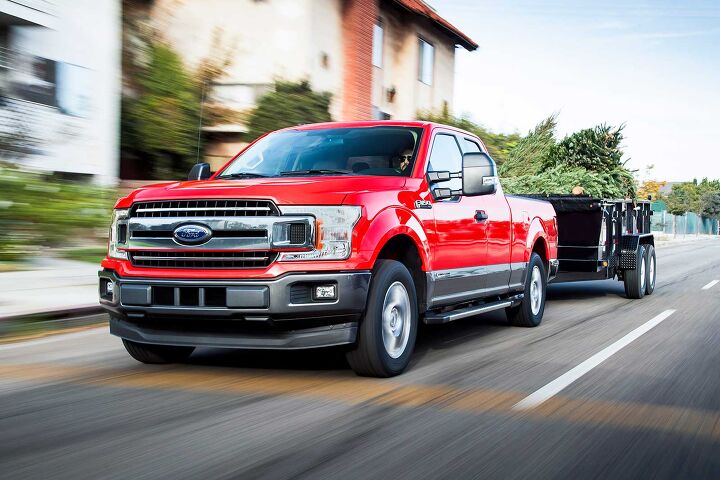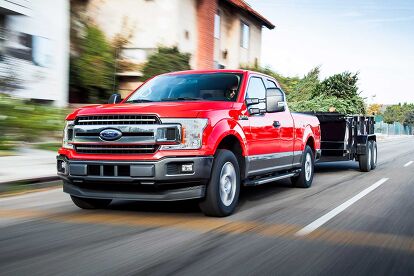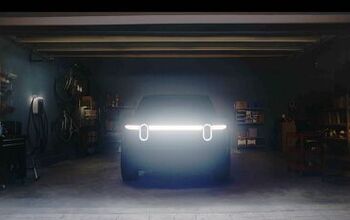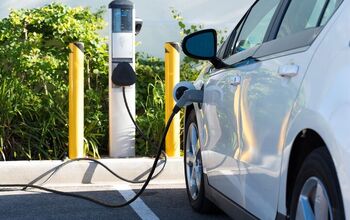Ford F-150 Diesel Numbers Announced: 250 HP, 440 LB-FT, 30 MPG

After a year of waiting, Ford has finally released the F-150 diesel’s output figures and they’re nothing if not impressive.
This tough truck’s 3.0-liter Power Stroke V6 will deliver 250 horsepower and a whopping 440 pound-feet of torque, the latter of which peaks at a basement-level RPM, just 1,750 on the tachometer. These figures narrowly outmuscle the EcoDiesel-equipped Ram 1500, which is rated at 240 hp and 420 lb-ft, though the all-new, soon-to-be-revealed 2019 model may tip the scales once again.
Perhaps even more impressive than these output numbers, the new oil-burning F-150 is estimated to deliver up to 30 miles per gallon on the highway, though official EPA figures will not be released until spring. If the truck can deliver, that’s a significant milestone in the full-size pickup segment.
Helping enable this likely best-in-class fuel economy is a standard 10-speed automatic transmission. Naturally, two- and four-wheel drive is offered.
But just because this truck is efficient, doesn’t mean it can’t work hard. That 3.0-liter Power Stroke engine enables a tow rating of 11,400 pounds (5,171 kg) with a cargo capacity of more than a ton (2,020 lbs/916 kg).
Designed by the same team that built Ford’s 6.7-liter Power Stroke diesel used in its Super Duty truck range, the new 3.0-liter oil-burner’s cylinder block is made from compacted-graphite iron, a tough-as-nails material that bodes well for the longevity of this compression-ignition engine. For added toughness, the crankshaft is made of forged steel.
SEE ALSO: 2017 Ford F-150 Review
Getting ample amounts of air into this engine at all speeds and loads is a variable-geometry turbocharger. Dual fuel filters should provide enhanced long-term durability, while a common-rail injection system operating at 29,000 PSI (2,000 bar) enables quiet, efficient operation.
Further aiding efficiency is a two-stage oil pump, which has fewer parasitic losses under light loads, though curiously, engineers opted to equip this 3.0-liter Power Stroke V6 with a mechanical rather than electrically operated fan. This seems like a step backward, but the reasoning is sound. Engine-driven fans can supposedly move more air in extreme conditions, which is necessary to keep the powertrain cool while, say, towing an overloaded trailer up a mountain in the desert during an August heat wave. Dual radiator shutters help improve aerodynamics when maximum cooling is not required.
With the addition of this diesel option, Ford will offer F-150 customers half-a-dozen engine choices, from a base V6, to three EcoBoost gasoline options (including the Raptor’s high-output 3.5-liter unit), to a 5.0-liter V8, there’s something for practically every kind of customer.
Dealers will begin taking orders for the diesel-powered 2018 Ford F-150 in the middle of this month. Deliveries are expected to commence in the spring. Pricing and official fuel-economy figures have not been released.
Discuss this story on our Ford Forum

Born and raised in metro Detroit, Craig was steeped in mechanics from childhood. He feels as much at home with a wrench or welding gun in his hand as he does behind the wheel or in front of a camera. Putting his Bachelor's Degree in Journalism to good use, he's always pumping out videos, reviews, and features for AutoGuide.com. When the workday is over, he can be found out driving his fully restored 1936 Ford V8 sedan. Craig has covered the automotive industry full time for more than 10 years and is a member of the Automotive Press Association (APA) and Midwest Automotive Media Association (MAMA).
More by Craig Cole








































Comments
Join the conversation
first year ford diesel sounds like a smart idea.....Remember the 6.0..This thing is a disaster waiting to happen. Ill stick with fords best engine,the 5.0
Unfortunately I don't consider 1750 RPM 'basement' torque... Although coupled to a 10 speed automatic, it's not like you have to worry about slipping the clutch to get going on a hill.